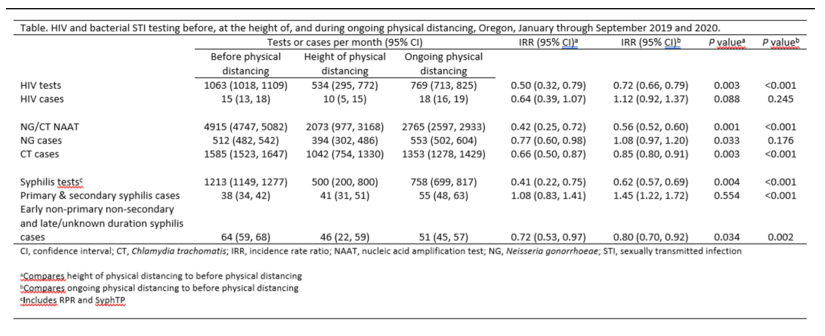 |
 |
 |
| |
DRAMATIC DECLINE IN PUBLIC SECTOR HIV/STI TESTING DURING SARS-CoV-2 PANDEMIC, OREGON
|
| |
| |
Presented During:
Oral Abstract Session
Tuesday, Mar 9, 2021: 12:35 PM - 12:45 PM
Virtual CROI 2021
Authors: Timothy W. Menza1, Amy Zlot2, Jillian Garai2, Sarah Humphrey2, Josh Ferrer2
Institutions: 1Oregon Health & Science University, Portland, OR, OR, 2Oregon Health
Authority, Portland, OR
Presenting Author: Dr Timothy Menza, MD, PhD
Background:
The SARS-CoV2 pandemic has dramatically affected public HIV and STI programs in the US. We determined the impact of SARS-CoV2 on public sector HIV and bacterial STI testing and diagnosis in Oregon.
Methods:
We examined the periods of January through September of 2019 and 2020. We defined January through September 2019 and January through February 2020 as "before physical distancing," March 2020 through May 2020 as "the height of physical distancing" and June through September 2020 as "ongoing physical distancing." We used Poisson regression with robust standard errors to estimate incidence rate ratios and 95% confidence intervals (CI) comparing monthly HIV and bacterial STI testing and diagnosis rates during each phase of physical distancing.
Results:
HIV and STI testing and diagnoses declined during physical distancing to nadirs in April and May 2020, with variable increases thereafter. Compared to before physical distancing, monthly HIV, NG/CT, and syphilis testing decreased both at the height of (by 50%, 58%, and 59%, respectively) and during ongoing physical distancing (by 28%, 44%, and 38%, respectively). Testing did not return to 2019 levels by September 2020. Monthly CT cases and early non-primary non-secondary and late/unknown duration syphilis cases were lower during both phases of physical distancing compared to before physical distancing. NG cases decreased 23% (95%CI: 2-40%) at the height of physical distancing but were comparable before physical distancing and during ongoing physical distancing. Compared to before physical distancing, HIV cases were 36% lower at the height of physical distancing and 12% greater during ongoing physical distancing; neither difference was statistically significant. In contrast, primary and secondary syphilis cases were 45% (95%CI: 22-72%) greater during ongoing physical distancing.
Conclusion:
Public sector HIV and bacterial STI testing declined following implementation of physical distancing measures for SARS-CoV2 in Oregon. The large declines in testing likely reflect decreased access to/utilization of screening services during physical distancing, as cases of CT and early non-primary non-secondary and late/unknown duration syphilis, infections that are likely to present asymptomatically, decreased significantly. Primary and secondary syphilis diagnoses increased, however, indicating ongoing sexual risk during physical distancing. Lack of timely diagnosis and treatment of HIV/STI during physical distancing may lead to increased transmission.

|
| |
|
 |
 |
|
|